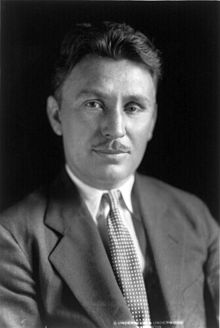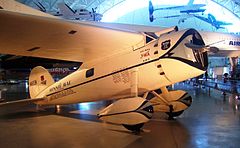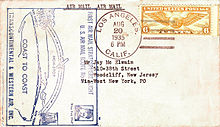- Wiley Post
-
Wiley Post 
Born Wiley Hardeman Post
November 22, 1898
Van Zandt County, Texas, U.S.A.Died August 15, 1935 (aged 36)
Point Barrow, Alaska, U.S.A.Occupation Aviator Spouse Mae Laine (m. June 27, 1927) Children None Parents William Francis Post and Mae Quinlan Post  "Winnie Mae" a Lockheed Vega aircraft of Wiley Post, when it was on display at the Steven F. Udvar-Hazy Center
"Winnie Mae" a Lockheed Vega aircraft of Wiley Post, when it was on display at the Steven F. Udvar-Hazy Center
Wiley Hardeman Post (November 22, 1898 – August 15, 1935) was a famed American aviator, the first pilot to fly solo around the world. Also known for his work in high altitude flying, Post helped develop one of the first pressure suits. His Lockheed Vega aircraft, the Winnie Mae, was on display at the National Air and Space Museum's Steven F. Udvar-Hazy Center from 2003 to 2011. On August 15, 1935, Post and American humorist Will Rogers were killed when Post's aircraft crashed on takeoff from a lagoon near Point Barrow, in Alaska.
Contents
Early flying career
Post was born in Grand Saline, Texas (Van Zandt County), to farmer parents William Francis and Mae Quinlan Post, but his family moved to Oklahoma when he was five. His aviation career began at age 26 as a parachutist for a flying circus, Burrell Tibbs and His Texas Topnotch Fliers, and he became well known on the barnstorming circuit. On October 1, 1926, an oil field accident cost him his left eye, but he used the settlement money to buy his first aircraft. Around this time, he met fellow Oklahoman Will Rogers when he flew Rogers to a rodeo, and the two eventually became close friends. Post was the personal pilot of wealthy Oklahoma oilmen Powell Briscoe and F.C. Hall in 1930 when Hall bought a high-wing, single-engine Lockheed Vega, one of the most famous record-breaking aircraft of the early 1930s. The oilman nicknamed it, the Winnie Mae, after his daughter, and Post achieved his first national prominence in it by winning the National Air Race Derby, from Los Angeles to Chicago. The fuselage was inscribed, "Los Angeles to Chicago 9 hrs. 8 min. 2 sec. August 27, 1930." Adam Charles Williams finished second with a time of 9 hrs. 9 min. 4 sec.
Around the world
With Harold Gatty
Like many pilots at the time, Post disliked the fact that the speed record for flying around the world was not held by a fixed-wing aircraft, but by the Graf Zeppelin, piloted by Hugo Eckener in 1929 with a time of 21 days. On June 23, 1931, Post and his navigator, Harold Gatty, left Roosevelt Field on Long Island, New York in the Winnie Mae with a flight plan that would take them around the world, stopping at Harbour Grace, Flintshire, Hanover twice, Berlin, Moscow, Novosibirsk, Irkutsk, Blagoveshchensk, Khabarovsk, Nome where his airscrew had to be repaired, Fairbanks where the airscrew was replaced, Edmonton, and Cleveland before returning to Roosevelt Field. They arrived back on July 1, after traveling 15,474 miles (24,903 km) in the record time of 8 days and 15 hours and 51 minutes. The reception they received rivaled Charles Lindbergh's everywhere they went. They had lunch at the White House on July 6, rode in a ticker-tape parade the next day in New York City, and were honored at a banquet given by the Aeronautical Chamber of Commerce of America at the Hotel Astor. After the flight, Post acquired the Winnie Mae from F.C. Hall, and he and Gatty published an account of their journey titled, Around the World in Eight Days, with an introduction by Will Rogers.
First solo pilot
After the record-setting flight, Post wanted to open his own aeronautical school, but could not raise enough financial support because of doubts many had about his rural background and limited formal education. Motivated by his detractors, Post decided to attempt a solo flight around the world and to break his previous speed record. Over the next year, Post improved his aircraft by installing an autopilot device and a radio direction finder that were in their final stages of development by the Sperry Gyroscope Company and the United States Army. In 1933, he repeated his flight around the world, this time using the auto-pilot and compass in place of his navigator and becoming the first to accomplish the feat alone. He departed from Floyd Bennett Field and continued on to Berlin where repairs were attempted to his autopilot, stopped at Königsberg to replace some forgotten maps, Moscow for more repairs to his autopilot, Novosibirsk, Irkutsk for final repairs to the autopilot, Rukhlovo, Khabarovsk, Flat where his airscrew had to be replaced, Fairbanks, Edmonton, and back to Floyd Bennett Field. Fifty thousand people greeted him on his return on July 22 after 7 days, 19 hours - 21 hours less than his previous record, and he was given a second ticker-tape parade in New York.
Pressure suit
In 1934, with financial support from Frank Phillips of the Phillips Petroleum Company, Post began exploring the limits of high-altitude long-distance flight. The Winnie Mae's cabin could not be pressurized, so he worked with Russell S. Colley of the B.F. Goodrich Company to develop what became the world's first practical pressure suit. Three pressure suits were fabricated for Wiley Post; only the final version proved successful. The first suit ruptured during a pressure test. The redesigned second suit used the same helmet as the first but when tested was too tight and they were unable to remove it from Post, so they had to cut him out thus destroying the suit. The third suit was redesigned from the previous two.[1][2]
The body of the suit had three layers: long underwear, an inner black rubber air pressure bladder, and an outer layer made of rubberized parachute fabric. The outer layer was glued to a frame with arm and leg joints that allowed him to operate the flight controls and to walk to and from the aircraft. Attached to the frame were pigskin gloves, rubber boots, and an aluminum-and-plastic diver's helmet. The helmet had a removable faceplate that could be sealed at a height of 17,000 ft, and could accommodate earphones and a throat microphone. The helmet was cylinder-shaped with a circular window. In the first flight using the suit on September 5, 1934, Post reached an altitude of 40,000 ft above Chicago. Eventually flying as high as 50,000 ft, Post discovered the jet stream and made the first major practical advances in pressurized flight.[3] As of 2010 the suit is being prepared for display at the National Air and Space Museum's Steven F. Udvar-Hazy Center.[4]
Attempted high altitude non-stop transcontinental flights
Between February 22 and June 15, 1935, Post made four unsuccessful attempts to complete the first high altitude non-stop flight from Los Angeles to New York, all of which failed for various mechanical reasons. The first attempt on February 22 ended just 57.5 miles East of Los Angeles at Muroc, CA. This was followed by attempts on March 15 (Cleveland, Ohio; 2,035 miles), April 14 (Lafayette, Indiana; 1,760 miles), and June 15 (Wichita, KS; 1,188 miles). As the attempts were also meant to be the "First Air Mail Stratosphere Flight" over U.S. Air Mail Route #2 (AM-2) from Los Angeles to New York, Post also carried a quantity of cacheted covers sponsored by Transcontinental & Western Air, Inc on all four flights. When Post was killed on August 15, 1935, thus ending the possibility of any more attempts to complete the AM-2 stratosphere flight, the covers were finally cancelled in Los Angeles on August 20, 1935, and forwarded to their addressees.
Final flight and death
In 1935 Post became interested in surveying a mail-and-passenger air route from the West Coast of the United States to Russia. Short on cash, he built a hybrid using parts salvaged from two different aircraft: the fuselage of an airworthy Lockheed Orion and the wings of a wrecked experimental Lockheed Explorer. The Explorer wing was six feet longer in span than the Orion's original wing, an advantage which extended the range of the hybrid aircraft. As the Explorer wing did not have retractable landing gear, it also lent itself to the fitting of floats for landing in the lakes of Alaska and Siberia. Lockheed flatly refused to make the modifications Post requested on the grounds that the two designs were incompatible and potentially a dangerous mix, leaving him no alternative but to make the changes himself.[5]
Post's friend Will Rogers visited him often at the airport in Burbank, California while Pacific Airmotive Ltd. was modifying the aircraft,[6] and asked Post to fly him through Alaska in search of new material for his newspaper column. When the floats Post had ordered did not arrive at Seattle in time, he used a set that was designed for a larger type, making the already nose-heavy hybrid aircraft still more nose-heavy.[7] However, according to the research of Bryan Sterling, the floats were the correct type for the aircraft.[5]
After making a test flight in July, Post and Rogers left Seattle in early August and made several stops in Alaska. While Post piloted the aircraft, Rogers wrote his columns on his typewriter. Before they left Fairbanks they signed and mailed a yacht club burgee belonging to South Coast Corinthian Yacht Club. The signed Burgee is on display at South Coast Corinthian Yacht Club in Marina del Rey, California. On August 15, they left Fairbanks, Alaska for Point Barrow. They were a few miles from Point Barrow when they became uncertain of their position in bad weather and landed in a lagoon to ask directions. On takeoff, the engine failed at low altitude, and the aircraft, uncontrollably nose-heavy at low speed, plunged into the lagoon, shearing off the right wing and ended inverted in the shallow water of the lagoon. Both men died instantly.[8]
Honors and tributes
In 1936, the Smithsonian Institution acquired the Winnie Mae from Post's widow for $25,000. The United States Congress authorized the purchase on August 24, 1935, just nine days after Post's death in Alaska. Two monuments at the crash site commemorate the death of the two men and are listed on the National Register of Historic Places.[9] The nearby Wiley Post–Will Rogers Memorial Airport located in Barrow, Alaska bears his name.
Wiley Post Airport, a large FAA designated reliever airport in Oklahoma City is named after Post. The major commercial airport is named after Will Rogers, so that both victims of the crash are honored by airports in Oklahoma City. The Will Rogers - Wiley Post Memorial Seaplane Base is a seaplane base located on Lake Washington, at the north end of the Renton Municipal Airport in Renton, Washington.
Wiley Post received the Distinguished Flying Cross (1932), the Gold Medal of Belgium (1934), and the International Harmon Trophy (1934). He was enshrined in the National Aviation Hall of Fame in 1969.[10] In 1979, the United States Postal Service honored him with two airmail stamps.[11]
References
- Notes
- ^ Young 2009, pp. 13–16.
- ^ Kozloski 1994, pp. 11–14.
- ^ Mallan 1971, p. 31.
- ^ "Wiley Post suit in Rocketry and Space Flight." National Air & Space Museum via nasm.si.edu. Retrieved: July 18, 2010.
- ^ a b Sterling 2001, p. 164.
- ^ Sterling 2001, pp. 167–169.
- ^ Johnson and Mohler. Wiley Post, His Winnie Mae, and the World's First Pressure Suit. p. 112. Retrieved: 3 April 2009.
- ^ Sterling 2001, p. 246.
- ^ "Rogers-Post Site." National Park Service. Retrieved: April 3, 2009.
- ^ "Wiley Post: Dare Devil." National Aviation Hall of Fame (NAHF), 2006. Retrieved: April 3, 2009.
- ^ Horwitz, Ed. "Wiley Post remembered as aviation pioneer." Stamps, 1995. ISSN 0038-9358.
- Bibliography
- Johnson, Bobby H. "Post, Wiley Hardeman." The Texas State Historical Association. Retrieved: April 3, 2009.
- Johnson, Bobby H. and R. Stanley Mohler. Wiley Post, His Winnie Mae, and the World's First Pressure Suit. Washington, DC: Smithsonian Institution, 1971. ISBN 978-0806137681.
- Kozloski, Lillian D. U.S. Space Gear: Outfitting The Astronaut. Washington, DC: Smithsonian Institution Press, 1994. ISBN 0-87474-459-8.
- "Lockheed 5C Vega." Smithsonian National Air and Space Museum. Retrieved: April 3, 2009.
- Mallan, Lloyd. Suiting Up For Space: The Evolution of the Space Suit. New York: The John Day Company, 1971.
- Onkst, David H. "Wiley Post." U.S. Centennial of Flight Commission. Retrieved: 3 April 2009.
- Post, Wiley.Around The World In Eight Days. New York: Crown Book, reprint 1989. ISBN 0-51757-352-0.
- Sterling, Bryan and Frances. Forgotten Eagle: Wiley Post: America's Heroic Aviation Pioneer. New York: Carroll & Graf Publishers, 2001. ISBN 0-78670-894-8.
- "Wiley Post.". Century of Flight. Retrieved: April 3, 2009.
- "Wiley Post and the Winnie Mae." AcePilots.com, 2003. Retrieved: April 3, 2009.
- Young, Amanda. Spacesuits: The Smithsonian National Air and Space Museum Collection. Brooklyn, NY: House Cultural Entertainment Inc., 2009. ISBN 978-1-57687-498-1.
External links
- "Wiley Post seeks New Record" Popular Mechanics, October 1934 pp.492-494
- Renton Municipal Airport - Will Rogers-Wiley Post Seaplane Base.
- C95 Wiley Post Stamp
- C96 Wiley Post Stamp
Categories:- American aviators
- Aviation pioneers
- Harmon Trophy winners
- Recipients of the Distinguished Flying Cross (United States)
- Aviators killed in aviation accidents or incidents in the United States
- People from Van Zandt County, Texas
- People from Oklahoma
- 1898 births
- 1935 deaths
- Accidental deaths in Alaska
- National Aviation Hall of Fame inductees
Wikimedia Foundation. 2010.



